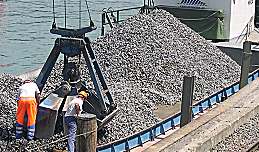|
Persistence (discontinuity)
Persistence determines the possibilities of relative movement along a discontinuity in a soil or rock mass in geotechnical engineering. Discontinuities are usually differentiated in persistent, non-persistent, and abutting discontinuities (figure). Persistent discontinuity A ''persistent discontinuity'' is a continuous plane in a soil or rock mass. Shear displacement takes place if the shear stress along the discontinuity plane exceeds the shear strength of the discontinuity plane. Non-persistent discontinuity A ''non-persistent discontinuity'' ends in intact soil or rock. Before movement of the material on both sides of a non-persistent discontinuity is possible, the discontinuity has to extend and break through intact material. As intact material has virtually always far higher shear strength than the discontinuity, a non-persistent discontinuity will have larger shear strength than a persistent discontinuity. Abutting discontinuity An ''abutting discontinuity'' abuts aga ... [...More Info...] [...Related Items...] OR: [Wikipedia] [Google] [Baidu] |
Geotechnical Engineering
Geotechnical engineering is the branch of civil engineering concerned with the engineering behavior of earth materials. It uses the principles of soil mechanics and rock mechanics for the solution of its respective engineering problems. It also relies on knowledge of geology, hydrology, geophysics, and other related sciences. Geotechnical (rock) engineering is a subdiscipline of geological engineering. In addition to civil engineering, geotechnical engineering also has applications in military, mining, petroleum, coastal engineering, and offshore construction. The fields of geotechnical engineering and engineering geology have knowledge areas that overlap, however, while geotechnical engineering is a specialty of civil engineering, engineering geology is a specialty of geology: They share the same principles of soil mechanics and rock mechanics, but differ in the application. History Humans have historically used soil as a material for flood control, irrigation purposes, buria ... [...More Info...] [...Related Items...] OR: [Wikipedia] [Google] [Baidu] |
Rock Mechanics
Rock mechanics is a theoretical and applied science of the mechanical behavior of rock and rock masses; compared to geology, it is that branch of mechanics concerned with the response of rock and rock masses to the force fields of their physical environment. 

[...More Info...] [...Related Items...] OR: [Wikipedia] [Google] [Baidu] |
Pergamon Press
Pergamon Press was an Oxford-based publishing house, founded by Paul Rosbaud and Robert Maxwell, that published scientific and medical books and journals. Originally called Butterworth-Springer, it is now an imprint of Elsevier. History The core company, Butterworth-Springer, started in 1948 to bring the "Springer know-how and techniques of aggressive publishing in science"Joe Haines (1988) ''Maxwell'', Houghton Mifflin, p. 137. to Britain. Paul Rosbaud was the man with the knowledge. When Maxwell acquired the company in 1951, Rosbaud held a one-quarter share. They changed the house name to Pergamon Press, using a logo that was a reproduction of a Greek coin from Pergamon. Maxwell and Rosbaud worked together growing the company until May 1956, when, according to Joe Haines, Rosbaud was sacked. When Pergamon Press started it had only six serials and two books. Initially the company headquarters was in Fitzroy Square in West End of London. In 1959, the company moved into Headingt ... [...More Info...] [...Related Items...] OR: [Wikipedia] [Google] [Baidu] |
Soil Mechanics
Soil mechanics is a branch of soil physics and applied mechanics that describes the behavior of soils. It differs from fluid mechanics and solid mechanics in the sense that soils consist of a heterogeneous mixture of fluids (usually air and water) and particles (usually clay, silt, sand, and gravel) but soil may also contain organic solids and other matter.Mitchell, J.K., and Soga, K. (2005) Fundamentals of soil behavior, Third edition, John Wiley and Sons, Inc., .Powrie, W., Spon Press, 2004, ''Soil Mechanics – 2nd ed'' A Guide to Soil Mechanics, Bolton, Malcolm, Macmillan Press, 1979. Along with rock mechanics, soil mechanics provides the theoretical basis for analysis in geotechnical engineering, a subdiscipline of civil engineering, and engineering geology, a subdiscipline of geology. Soil mechanics is used to analyze the deformations of and flow of fluids within natural and man-made structures that are supported on or made of soil, or structures that are buried in soils.L ... [...More Info...] [...Related Items...] OR: [Wikipedia] [Google] [Baidu] |

